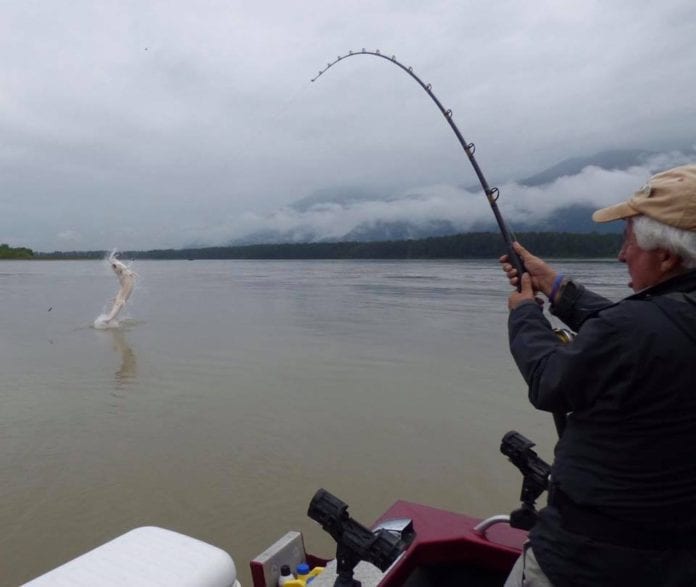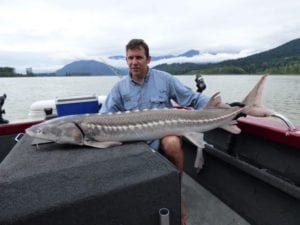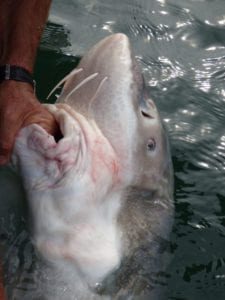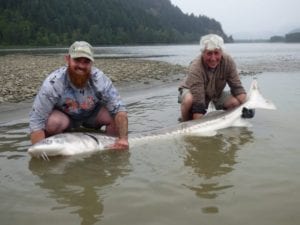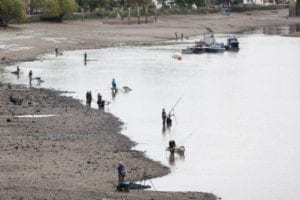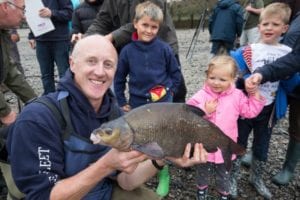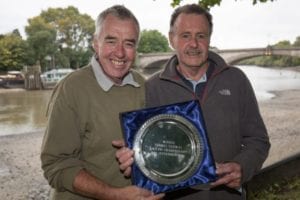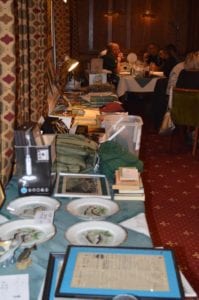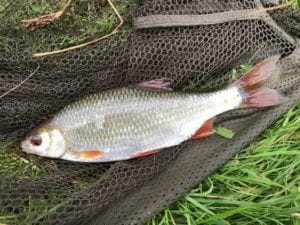Apologies for the radio silence of late but it’s been a somewhat crazy summer and I’ve simply not found the time to update this blog. In July I was invited to speak at a fisheries conference in Vancouver and when I got back it was straight into the arrangements for this year’s Tidefest on the Thames in London followed by my annual family holiday and then the Avon Roach Project fundraiser. The common thread running through all these diverse activities was the condition of our rivers and the fish stocks within them which gives a rather nice theme to re-start these occasional musings.
Return to the Fraser
Although I’ve fished some pretty amazing rivers in my time there has always been one place that kept calling me back – somewhere I first saw but never properly fished in 2001 whilst on honeymoon. A river that drains the Rocky Mountains in Canada and which flows with serenity and ferocity in equal measure through some of the most stunning landscapes on this planet. A river that is one of the few places to hold the giant, prehistoric, predatory fish – the great white sturgeon. It was these incredible creatures, often living to over 100 years and growing to 1,000 pounds and more, that had brought me back to the Fraser River after a 16 year break.
The opportunity arose when Vancouver Island was announced as the venue for the eighth World Recreational Fishing Conference and I was asked to present a talk on engaging anglers in political advocacy and practical action for river restoration.
The Canadians certainly made WRFC8 a huge success with nearly 400 attendees, representing 21 different countries, participating in 4 days of presentations, workshops, idea sharing and useful networking, making it the most attended World Recreational Fishing Conference to date. I’ve never attended one of these before, and the UK delegation was far smaller than many other countries, but there is great benefit in us being part of a global community of experts, academics, fishery managers and industry leaders all committed to ensuring that the future of recreational fishing remains healthy and sustainable. No single country or jurisdiction gets it either all right or all wrong but the longer I work in this sector the more firmly I believe in the value of learning from both shining examples and dreadful errors.
There was a sizeable delegation from Australia at the conference including several friends and colleagues that I got to know in my time living Down Under. A quick email suggesting that it would be rude not to sample the delights of the Fraser River whilst we were over there elicited several promising replies including one from my mate, and renowned Australian fisheries scientist, Ben Diggles. Ben was up for the sturgeon challenge and so all we had to do was sort out who to go with.
Aussie fisheries scientist Ben Diggles was Martin’s sturgeon fishing partner on the Fraser.
A huge variety of guiding outfits, of varying quality, have sprung up throughout the lower Fraser valley since the legendary Fred Helmer begun offering visiting anglers the chance to pursue giant sturgeon in the 1980s. The one name that kept coming up trumps in the research I did was Cascade Fishing Adventures run by Marc and Maggie Laynes out of Chilliwack.
http://www.cascadefishingadventures.com/
Cascade are now the longest running guiding company in business on the Fraser with 27 years of experience under their belts and an enviable record of landing huge salmon and sturgeon from their well appointed boats and knowledgeable guides. A quick call to Maggie to arrange the dates and accommodation and Ben and I were all set to do battle with the Fraser River monsters when the time came.
The Fraser is an incredible ecosystem and holds all five species of Pacific salmon: Chinook, Coho, Chum, Pink, Sockeye, as well as Steelhead and Cutthroat Trout. Whilst a typical white sturgeon averages between 30 and 100 lbs – big enough for any freshwater fish – these are mere babies when compared to the giants which can exceed 12 feet in length and 1000lbs. In 2012 a massive white sturgeon weighing an estimated 1,100 lbs, and measuring over 12ft, was caught, released and claimed as the river record. Every year fish far larger are hooked and never seen as they simply cannot be brought to the boat or bank on conventional rod line no matter how strong the guy is at the other end.
http://greatriverfishing.com/world-record-sturgeon-fraser-river/
I’ve long ago given up being obsessed by the size of the fish I target and whilst I met guys out there on a mission to catch a 500 pounder (and good luck to them) I just wanted to experience the thrill of battling one or two of these prehistoric creatures in the beautiful surroundings of the Fraser Valley. As it turned out we were going to be having four full days on the sturgeon as the chinook season, which normally starts in mid July, had a delayed opening due to a drop in the numbers of fish entering the system. Although this was somewhat disappointing as both Ben and I were hoping for a bit of variety in the fishing it was an object lesson on the need to manage the exploitation of a fishery according to what the stock can handle rather than what fisherman – both commercial and recreational- think they’ve a God given right to catch.
The day starts at the very civilised time of 7.45am when Marc and his team pick up their clients from the hotel car park and take us on a short drive to the boat ramp. With the salmon season still closed the water was nowhere near as crowded as it can be when a fair few of Vancouver residents drive themselves a couple of hours or so up river in search of the chinooks.
We head off to a small backwater to catch some fresh bait. The rules in British Columbia prohibit the use of live baits but a freshly killed pike minnow is considered the next best thing. Other popular baits include lamprey sections, fish roe wrapped in a nylon mesh, and, a little later on in the season when the salmon are running in numbers, large lumps of salmon meat affectionately known as ‘stink bait’.
The main action came pretty quickly as within 15 minutes of anchoring at the head of a mid river gully my rod was away and I was battling the first fish of the trip. At six foot long and around 170lbs I was assured of a healthy workout and it didn’t disappoint. Mindful of the presence of a couple of nasty looking, partially sunken trees our guide steered the boat towards some quieter, safer water the confluence of one the tributaries. Whilst the area was snag free my sturgeon positively hated the clarity of water coming in from the smaller river and made several powerful runs back into the murkier depths of the Fraser. In the absence of a convenient looking beach we opted to unhook her by the side of the boat and save the trophy shots for another time and place. Quite rightly, strict conservation rules are in place and the guides are serious about fish welfare. Sturgeon are not able to support their own body weight out of the water and it is prohibited to bring any fish in excess of five feet aboard a boat. And those that do come aboard for tagging or a photograph are to be supported in a sling.
The business end of a great white sturgeon
Ben and I ended a memorable four days on the Fraser with 14 fish to 220lbs. Fabulous hard fighting predators that run, jump and make you work for every yard of line. All caught in one of the greatest rivers on Earth surrounded by snow capped mountains. What’s not to like?!
220lbs of Fraser River muscle. I didn’t feel the need to catch anything much bigger! And below the big river in all its glory.
Totally Thames
For the last four years I have been charged with organising TideFest on the tidal Thames in London, heading up the organising committee which includes the Angling Trust, London Wildlife Trust, ZSL, River Thames Society, Thames 21 and many other local groups. The festival is now an established River Thames event which aims to highlight the recreational importance of the Thames to Londoners and encourage people to ‘enjoy the river’. It is part of the month long Totally Thames Festival and is sponsored by Thames Water. This year’s programme saw events at Richmond, Chiswick Pier, Brentford, Barnes, Deptford, Hackney, Beckton, and other locations along the Thames Tideway. The activities included paddleboarding, kayaking, foreshoe walks, boat trips, museum and Nature Reserve visits and, of course, a fishing match.
For a river that was ‘biologically dead’ in the 1950s how Good is it see anglers enjoying great sport on the Thames in the middle of London?
50 anglers took part in this year’s Tidefest Angling Championship which saw some good weights of bream taken from Strand on the Green with the winner Mike Smith landing over 28lbs from his peg beside Kew Railway bridge. A small barbel was landed at Chiswick and most competitors caught several eels which is a good sign to see them returning to the river. The weights were down on last year and there was no sign of the big roach that have been a feature of catches in previous matches but I suspect the low flows had seen a migration of roach and dace further up the river and out of the more saline match length. Certainly the roach sport at the top of the tideway at Richmond has been superb and there is no shortage of fish in the river as a whole.
Simon Clarke of Tackle Up in Fleet impresses the kids with his catch
In fact, the match weights in the middle reaches around Reading and Oxford where I live have been as good as anyone can remember. Only last week our local winter league was won with a staggering 47lbs of pole caught roach and skimmers and in most club matches anglers have needed 20lbs plus of roach to make the frame. Those doom-mongers who keep telling us that river fishing is finished should spend a bit more time on the Thames and a bit less on Facebook in my opinion!
Angling Times columnist and Thames enthusiast Keith Arthur presents Mike Smith with his Tidefest winners trophy.
Avon calling
The Kennet and the Thames may be my local rivers but the Hampshire Avon is a special place that will always remain important to me. It gave me my first double figure barbel in the 1980s along with some wonderful roach and chub. The river was subsequently so badly hit by cormorant predation that the EA fish survey in 2005 showed only minuscule populations of roach remaining largely in the urban areas around Christchurch and Salisbury where the birds are less willing to do their dreadful damage. With numbers at below critical mass there was a real danger that the wonderful Avon roach could be consigned to the history books.
Trevor Harrop – the driving force behind the Avon Roach Project
Unfortunately too many anglers are better at moaning than they are at trying find solutions but not so Budgie Price and Trevor Harrop, the driving force behind the award winning Avon Roach Project. Now in its eighth year, tens of thousands of pure Avon roach have been bred from the spawn of the surviving population and released back into the river to kick start the process of natural recruitment. You can read more about their fantastic work here: http://www.avonroachproject.co.uk/
Some of the great auction lots on display at this year’s Avon Roach Project fundraiser.
Every year a load of us roach nuts gather to hold what Trevor describes as “a friendly match to the death” on the Avon followed by a fabulous fundraising dinner and auction. The winner is the captor of the best fish, to be decided on a largely arbitrary basis by Trevor. A big dace may beat a good barbel, specimen chub have taken the trophy in the past but a decent roach is always going to find favour with the judges. I guess the clue is in the name and thanks to the sterling efforts of the project more and more redfins are showing up in the catches. My mate, and Classic Angling editor, Keith Elliott landed 48 of them on Saturday from a single swim on the lower Royalty. Believe me it’s been an awful long time since catches of roach like that were made in matches.
Small pristine roach like this are now appearing regularly in catches on the Hampshire Avon.
I too decided to fish the Royalty, mainly for nostalgic reasons as I hadn’t been there in a while, and with the river running low and clear it was always going to be a struggle. In the end I was pleased to catch a net of small chub as this is a species that has not been recruiting well in other rivers. Most importantly we raised over £6000 at the auction and raffle where some fantastic lots attracted many generous bids from ARP supporters. My favourite moment was the auction of the Bob James centrepin – which is apparently suitable for fishing both in and out of season!
I’m now looking forward to some proper winter fishing on the rivers once the leaves have gone and the weed has died back. We desperately need some rain but when it comes I shall be out there running a float down some favourite swims in search of big roach, chub, perch and grayling and if it colours up I know a few spots where some clonking great barbel might just be tempted to drag my rod tip round a yard or two. There’s a right, royal riverfest to be had these days and we should make the most of it.
Martin Salter
To comment on this article, go to: https://www.fishingmagic.com/forums/fm-news-feature-comments/362072-martin-salter-something-rivers-festa.html#post1437960










